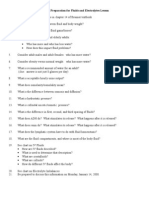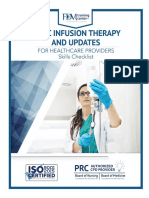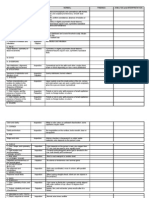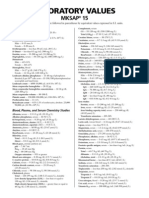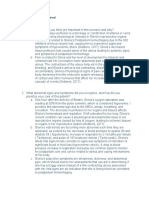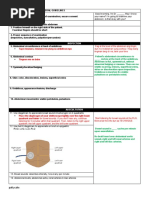Assessing Neurologic Functions
Uploaded by
Denise DizonAssessing Neurologic Functions
Uploaded by
Denise DizonAssessing Neurologic Functions
By Evergisto Casem Garcia, Jr. RN-MSN
HEALTH ASSESSMENT INTERVIEW TO COLLECT
SUBJECTIVE DATA
-
If clients ability to communicate is
challenged by altered level of
consciousness, interviewer may discuss
with family members or close friend
If client has a health problem involving
neurologic function, determine:
Onset
Characteristic and course
Severity
Precipitating and Relieving factors
Associated symptoms noting timing
and circumstances
Questions about present status include:
Numbness and tingling sensation
Tremors, problems with coordination
or balance
Loss of movement of any part of the
body
Difficulty with speaking or senses
Information about memory
Feeling state (anxious, depressed)
Changes in sleep pattern
Ability to perform self-care and ADL
Sexual activity
Weight changes
Prescribed and over the counter
medications, frequency of use and
duration
Determine History of:
Seizures
Fainting
Dizziness
Headache
Trauma
Tumors
Surgery involving brain, spinal cord,
nerves
Diseases that might affect neurologic
function:
Cardiac disease
Strokes
Pernicious anemia
Sinus infections
Liver dysfunctions
Diabetes mellitus
Hypertension
Assessment of:
Usual diet
Use of tobacco, drugs, alcohol
Following safety precautions; risk taking
behavior
PHYSICAL ASSESSMENT TO COLLECT OBJECTIVE
DATA
Mental health problems
Determine if client is exposed to any
occupational hazard
Exposure to toxic chemicals or materials
Use of protective headgear
Time spent in performing repetitive
motions
Mental Status Assessment with Abnormal
Findings
Unilateral Neglect:
Strokes involving MCA
Poor hygiene and Grooming:
dementing disorders
Abnormal gait and posture:
TIAs, Strokes, Parkinsons
Emotional swings, personality changes:
strokes of anterior cerebral artery
Masklike appearance on face:
Parkinsons Disease
Aphasia(defective or absent language
function):
TIAs, strokes, strokes involving
posterior or anterior artery involve
receptive aphasia)
Dysphonia (change in the tone of the
voice):
strokes of posterior inferior cerebral
artery, paralysis of vocal cords, cranial
nerve X
Dysarthria (difficulty in speaking):
strokes involving anterior, inferior and
superior cerebral arteries, lesions
involving UMN, LMN, cerebellum,
extrapyramidal tract
Decreased level of consciousness:
brain trauma, infections, TIAs, stroke,
brain tumors
Confusion, coma:
strokes affecting vertebral basilar
arteries
Cognitive Function Assessment with
Abnormal Findings
Disorientation to time and place:
stroke of right cerebral hemisphere
Memory deficits:
anterior cerebral artery and vertebral
basilar artery
Perceptual deficits:
strokes of middle cerebral artery, brain
trauma, dementing conditions
Impaired cognition:
strokes of middle cerebral artery, brain
trauma, dementing conditions
Cranial Nerve Assessment with Abnormal
Findings
CN I (Olfactory)
Anosmia (inability to smell)
Lesions of frontal lobe
Impaired blood flow to MCA
CN II (Optic)
Blindness in one eye: strokes of
internal carotid artery, TIAs
Homonymous hemianopia: (impaired
vision/blindness in one side of both
eyes): blockage of posterior cerebral
artery
Impaired vision: strokes of anterior
cerebral artery, brain tumor
Blindness, double vision: involvement
of vertebralbasilar arteries; double or
blurred vision may occur with TIAs
Papilledema(swelling of optic nerve):
increased intracranial pressure
CN III, IV, VI (oculomotor, trochlear,
abduscens)
Nystagmus (involuntary eye
movement): strokes of anterior,
inferior, superior cerebellar arteries
Constricted pupils: may signify
impaired blood flow to vertebral
basilar arteries
Ptosis: strokes posterior, inferior
cerebellar artery, myasthenia gravis,
palsy of CN III
CN V (Trigeminal): Changes in facial
sensations; impaired blood flow to carotid
artery
Decreased sensation to face and
cornea on same side of the body:
strokes of posterior inferior cerebral
artery
Lip and mouth numbness: strokes of
vertebral basilar arteries
Loss of facial sensation, contraction of
masseter and temporal muscles; lesions CN
V
Severe facial pain: trigeminal neuralgia (tic
douloureux)
CN VII (facial)
Loss of ability to taste: brain tumors,
nerve impairment
Decreased movement of facial muscles:
lesions of UMN, LMN
Inability to close eyes, flat nasolabial fold,
paralysis of lower face, inability to wrinkle
forehead: paralysis of LMN
Eyelid weakness, paralysis of lower face:
paralysis of UMN
Pain, paralysis, sagging of facial muscle:
affected side in Bells Palsy
CN VIII (Acoustic)
Decreased hearing or deafness: strokes of
vertebral basilar arteries or tumors of CN
VIII
CN IX and X ( glossopharyngeal, vagus)
Dysphagia (difficulty in swallowing):
impaired blood flow to vertebralbasilar
arteries, posterior or anterior, inferior or
superior cerebellar arteries
Unilateral loss of gag reflex: lesions of CN
IX and CN X
CN XI (Spinal Accessory)
Muscle weakness: LMN Disease
Contralateral hemiparesis: strokes
affecting middle cerebral artery and
internal carotid artery
CN XII (Hypoglossal)
Atrophy, fasciculations (twitches): LMN
Disease
Tongue deviation toward involved side of
the body
Sensory Function Assessment with
Abnormal Findings
Altered Sensations Occurs with Variety of
Neurological Pathology
Decreased pain sensation:
spinothalamic tract injury
Decreased vibratory sensation:
posterior column tract injury
Transient numbness of upper extremities:
TIAs
Sensory loss of one side of body:
lesions involving higher pathways to
spinal cord
Bilateral sensory loss:
Polyneuropathy
Impaired sensations:
stroke, brain tumor, spinal cord
compression or trauma
Motor Function Assessment with
Abnormal Findings
Muscle Atrophy:
LMN Diseases
Tremors:
activity seen with multiple sclerosis,
cerebellar disease
Tremors occurring at rest and abating
with movement commonly occur with
Parkinsons Disease
Fasciculation:
disease or trauma to LMN, side
effects of medications, fever, sodium
deficiency, uremia
Flaccidity (decreased muscle tone):
disease or trauma to LMN and early
stroke
Spasticity (increased muscle tone):
disease of corticospinal motor tract
Muscle rigidity:
disease of extrapyramidal motor
tract
Cogwheel rigidity (muscular
movement with small regular jerky
movement):
Parkinsons disease
Muscle weakness in arms, legs, hands:
TIAs
Hemiplegia (paralysis of half of body
vertically):
strokes involving internal carotid
artery and posterior cerebral artery
Weakness of extremities:
strokes involving vertebralbasilar
arteries
Flaccid paralysis:
strokes of anterior spinal artery
Paralysis, decreased movement:
multiple sclerosis or myasthenia
gravis
Total loss of motor function below
level of injury:
complete spinal cord transection,
injuries to anterior portion of spinal
cord
Spasticity of muscles:
incomplete spinal cord injuries
Cerebellar Function Assessment with
Abnormal Findings
Ataxia (lack of coordination and
clumsiness of movement; staggering,
wide-based and unbalanced gait):
anterior strokes, cerebellar tumors
Swaying and falling:
cerebellar ataxia
Inability to walk on toes then heels:
UMN disease
Spastic hemiparesis:
strokes or UMN disease
Steppage gait (client drags or lifts foot
high, then slaps foot onto floor; inability
to walk on heels):
disease of LMN
Sensory ataxia (client walk on heels
before bringing down toes and feet are
held wide-apart; gait worsens with eyes
closed):
polyneuropathy, damage to posterior
columns
Parkinsonian gait (stooped over position
while walking with shuffling gait with
arms held close to the side):
Parkinsons Disease
Positive Romberg Test:
Cerebellar Ataxia
Reflex Assessment with Abnormal Findings
Hyperactive reflexes:
lesions affecting UMN
Decreased reflexes:
LMN involvement
Clonus of foot (hyperactive, rhythmic
dorsiflexion and plantar flexion of foot):
UMN disease
Superficial reflexes (such as abdominal)
and cremasteric reflex may be absent
with LMN and UMN diseases
Positive Babinski reflex (dorsiflexion of
big toe with fanning of other toes):
UMN diseases of pyramidal tract
Special Neurologic Assessment with
Abnormal Findings
Positive Brudzinskis sign (pain,
resistance, flexion of hips and knees when
head flexed to chest with client supine):
indicates meningeal irritation
Positive Kernigs sign (excessive pain
and/or resistance when examiner
attempts to straighten knees with client
supine and knees and hips flexed)
indicates meningeal irritation
Decorticate posturing (upper arms close
to sides, elbows, wrists and fingers
flexed, legs extended with internal
rotation, feet are flexed; body parts
pulled into core of body):
lesions of corticospinal tract
Decerebrate posturing (neck extended
with jaw clenched, arms pronated,
extended, close to sides, legs are
extended straight out and feet plantar
flexed):
lesions of midbrain, pons, diencephalon
Nursing Care for the Bedridden
Personal Hygiene
Mouth Care
Eye Care
Bed Bath
Back Care
Head Bath
Perineal Care
Nutrition
Mobility
Communication
Treatment
Education and empowerment
Regular follow-up
Personal Hygiene
Bath
Nail care
Care of eye,ear,nose
Hair care
Oral care
Perineal care
Skin care
Cleanliness of the patient, bed and
surroundings are important.
A daily bed bath should be given to
cleanse, refresh and relax the patient.
A bath also promotes circulation,
provides a mild form of exercise and
cleanses the skin.
Allow the patient to bathe himself if hes
able.
Keep the bath water warm.
You may also need a bedpan.
Wash all parts of the body and dry
thoroughly.
Avoid chilling or tiring the patient.
Make a note of anything unusual so these
things can be reported to the HCP.
Follow up the bath by giving the patient a
back rub using either powder or lotion.
This rub will stimulate circulation and aid
in the prevention of pressure sores.
Assist the patient, if necessary, in
brushing his teeth or cleaning his
dentures.
Cleanse the patients entire mouth and
teeth as often as needed for his comfort
and always after hes eaten.
Brushing and combing the patients hair
will help maintain the health of the hair,
improve the patients appearance and
morale, and stimulate interest in personal
grooming.
Care of Bedridden Patient
BEDRIDDEN PATIENT
Disease
Trauma
Ageing
A person who is bedridden usually needs
full-time care and attention.
Care team will likely work together
It is important to make sure that every care
team member keeps a written record of
the patients care.
Any treatments and medications ordered
by the doctor and given to the patient
should be recorded. Including patients
appetite, bowel movements, body
temperature, PR & RR.
Comfort comes first
Support should be provided for the
patients back and joints to prevent strain.
The arms and legs should be positioned
comfortably and supported when
necessary.
When changing the patients position in
bed, communicate what you are going to
do to gain his or her cooperation.
Guide his movements rather than lifting
him if he is able to move himself
If the patient is unable to help him or
herself, a draw sheet and a second person
is usually required to move the patient
around the bed.
Maintain good posture and position.
Change linens often, providing several
pillows for support.
A hospital bed that can be adjusted will
also make the patient more comfortable,
as well as relieving back strain for the
caregiver.
If a patient looks better, he or she will
often feel better.
Help the male patient to shave, and help
the female patient put on her make up.
A shampoo should be given on a regular
schedule.
Finger and toenails should also be cleaned
and trimmed. If the skin of the hands and
feet becomes dry, apply a lotion after the
bath.
Nutrition
Assistance for feeding
Assessment& management of problems
in feeding
Dealing of misconceptions
Utilization of locally available food
Mobility
Motivate movement
Simple exercises
Encourage activities
Changing the Bed
The patients bed linen should be
changed every day or more often if it
becomes soiled.
Select a firm mattress and protect it
with a waterproof covering and a
cotton pad for the patients comfort.
A draw sheet across the middle of the
bed will protect the bottom sheet from
becoming soiled and it can be changed
more easily.
When changing the bed with the
patient in bed, move the patient to one
side and make half of the bed at a time.
Roll the patient back over the center of
the bed where both the clean and
soiled linen are gathered and complete
making the other half.
Be sure to allow toe space when
tucking in the top sheet and blanket.
The covers should be warm and
lightweight.
Turn the mattress and air the bedding
weekly.
Aims:
to prevent spinal cord injury and/or
ascension of injury
to prevent the development of
pressure sores
to facilitate assessment of the patient's
dorsal surface
to minimize manual handling risks
STANDARD
All patients will be safely log-rolled (2
hourly) with no adverse events such as
spinal cord injury, ascension of injury or
development of pressure sores.
Prepare Personnel and Resources
1. Obtain collar if required.
2. Obtain linen.
3. Obtain wash bowl with water, hygiene
and personal care equipment.
4. Adjust the bed to the correct height for all
personnel.
Organize Personnel
1. Identify how many people will be required
to roll patient (Five for a patient with
traction and four without).
2. Organize a skilled team to assist with the
roll.
3. Ensure team wear gloves, goggles and
aprons with arm protection for the head
hold person.
4. Check understanding of the team
members roles as follows
Check understanding of
the team members roles as follows:
Head Hold Person
Must be a registered nurse or
medical officer. This person
manages cervical spine
Alignment and is in control of the
roll. They must ensure all members
of the team are
Ready before proceeding and should
give clear instructions. Whilst the
head hold
Person takes their position
assistance is required to minimize
head movement.
Shows a patient without traction in
a stable position on their side.
Note the alignment of the spine
and the position of the head hold
person's hands
Shows the patient with traction in a
stable position on their side.
Note that the traction is in
alignment and the correct position
of the head hold person's hands
Head hold person gently inserts
their hands from the side
*Traction person minimizes head
movement
*A third person applies a shoulder brace
*The traction person minimizes head
movement as the 'head hold
Person slides their hands under the
head from the side of the bed. A
third
Person applies the shoulder brace.
Chest person
Should be the tallest person in the team
who places hands over the patients
shoulder and lower back
Hip person
This person is responsible for ensuring
the lower spine is not twisted during
the roll.
Places one hand near the lower hand of
the 'chest' person on the patient's
lower back and the other under the
patients thigh.
A pillow may be inserted between the
patients legs to maintain alignment.
Leg person
Each patient must be assessed on an
individual basis for manual handling risks.
A leg person is required for tall or heavy
patients or those in plaster.
The weight of the leg should be
supported from underneath.
Procedure for log-rolling a patient with
cervical spine injury
Hygiene person
The hygiene person is responsible for
maintaining safety of the lines and
artificial airway during the roll.
When the patient is balanced on their
side, the tubing can be supported on the
ventilator arm at which time patient
assessment and hygiene needs can be
attended.
The skin assessment is performed, which
includes the skin under the collar
(occiput).
Pressure Sore
Pressure sores are localized tissue
death and is the result of impairment of
vascular & lymphatic system of the skin
and tissues caused by compression
,tension or shear
Etiology
Pressure for a long time
Collapse of blood vessels
Nutrition ,Oxygen & tissue perfusion
Tissue ischaemia & hypoxia & cell death
Stress
Breakdown of skin
Causes
Intrinsic
Age
Neurological disease
Vascular disease
Nutritional status
Extrinsic
Pressure
Shear
Friction
Moisture
Immobility
Pathogenic organism
High Risk Groups
Bed ridden(old age, pain, sedated,
ascitis, oedema, coma,Depression,
agitated,dementia,fracture,paralysed )
Obese , very thin and emaciated
Diabetic patients
Incontinence-Bowel & Bladder
Excessive sweat or exudates
Hyperpyrexia
Malnourished
Preventive Measures
Maintenance of skin integrity
Daily examination of skin integrity /
pressure points
Pressure relief techniques
Promote patient movement
Improve nutrition & hydration
Education of pt & family
Minimize extrinsic factors
Common Sites
Depending on common position of patient
Supine
(occiput, elbows, saccral
region,heels,scapula )
Side lying
(ear, acromion process, ribs,greater
trochanter, medial &
lateralmaleolus,lateral condyles )
Sitting
(ischial tuberosity )
**See pictures on the last page**
STAGE I
Reddened area that returns to normal
color after 15-20 mins of pressure relief,
such as turning the client
Intact; red and doesnt blanch with
external pressure
STAGE II:
Area in which top layer of skin is missing
Ulcer is shallow with a pink to red base;
white or yellow eschar may be present
STAGE III:
Ulcer that extends to dermis and
subcutaneous tissues
White, gray, yellow eschar present at
the bottom of the ulcer
Ulcer crater may have a lip or edge
Purulent drainage is common
STAGE IV:
Deep ulcers extend into muscles and
bones
Foul smelling; brown/ black eschar
Purulent drainage is common
Management
AIM
Remove source of irritation
Necrotic tissue
Infection control
Protect new healthy tissue
Team work
Improve quality of life
Factors Helping to Cope with Aging
Physical health & activities
Mental health
Social activities
Prevention of accidents & Abuse
Health Teaching
Financial resources
Hypostatic Pneumonia
Pneumonia resulting from infection
developing in the dependent portions
of the lungs due to decreased
ventilation of those areas,
With resulting failure to drain bronchial
secretions; occurs primarily in old
people or those debilitated by disease
who remain recumbent in the same
position for long periods.
Signs and Symptoms
Chest Pain
The patient feels discomfort or
tightness in the chest due to the
blood not being able to circulate
properly throughout the lungs and
body.
Assessment of Pressure Sores
Site
Size
Shape
Stage
Presence of Necrotic or sluff tissue
Exudates
Undermining & Tunneling
Granulation & epithelial Tissue
Wound Edge
Surrounding Skin
Shortness of Breath
There is shallow breathing because
of the position of the body. The
lungs cannot get all the oxygen
they need because the diaphragm
is somewhat compressed.
Coughing
As the condition worsens, a cough
develops.
Sputum
Spitting up mucus, sometimes with
a little blood, indicates that the
lungs have filled with secretions.
Fever
If there pneumonia is cause by
bacteria, there could be fever.
Cyanosis
Cyanosis is a medical term that
indicates a blue tinge to the skin. It
means that there is not enough
oxygen in the blood.
Contracture
A muscle contracture is a permanent
shortening of a muscle
It is usually in response to prolonged
hypertonic spasticity in a concentrated
muscle area, such as is seen in the
tightest muscles of people with
conditions like spastic cerebral palsy.
Contractures are essentially muscles or
tendons that have remained too tight
for too long, thus becoming shorter.
Once they occur they cannot be
stretched or exercised away; they must
be released with orthopedic surgery.
Most of the physical therapy,
occupational therapy, and other
exercise
GLASGOW COMA SCALE (GCS)
Technique of objectifying a clients level
of responses
Clients best response in each area is
given a numerical value, and the three
values are totaled for a score ranging
from 3 - 15.
A score of 15 indicates client is awake
and oriented.
A score of 7 to 4 is considered coma.
The lowest score is 3,client is
considered in deep coma.
EYE OPENING
Spontaneous--------------------------------(4)
To voice / speech--------------------------(3)
To pain------------------------------------------(2)
None---------------------------------------------(1)
BEST MOTOR RESPONSE
Obeys commands-------------------------(6)
Localizes to pain---------------------------(5)
Flexor withdrawal(decorticate
posturing) -----------------------------------(4)
Abnormal flexion(decerebrate
posturing) -----------------------------------(3)
Extension -------------------------------------(2)
Flaccid ------------------------------------------(1)
BEST VERBAL RESPONSE
Oriented ---------------------------------------(5)
Confused conversation ---------------(4)
Inappropriate words -------------------(3)
Incomprehensible sounds -----------(2)
None ---------------------------------------------(1)
Limb Strength Assessment
Evaluation of limb responses provides
the assessor with detail of geographical
distribution of dysfunction
An important consideration when
performing a full neurological
assessment of patient
Each extremity is assessed and tested
unless there is a physical injury or other
problem in that limb
Categories for Limb Movements
Normal Power
Mild Weakness
Severe Weakness
Flexion
Extension
No Movement
Changes in motor strength especially
between Right and Left sides may
indicate imminent neurological failure
and should be reported immediately to
the nurse in charge and to the medical
team
You might also like
- Set v. Care of Clients With Physiologic and Psychosocial Alterations C (Answers)No ratings yetSet v. Care of Clients With Physiologic and Psychosocial Alterations C (Answers)11 pages
- UCLA Fundamentals of Clinical Medicine Physical Exam Skills Checklist Student - GroupNo ratings yetUCLA Fundamentals of Clinical Medicine Physical Exam Skills Checklist Student - Group5 pages
- LPN To RN Transitions 4th Ed - N. Harrington, C. Terry (Lippincott, 2013) WWNo ratings yetLPN To RN Transitions 4th Ed - N. Harrington, C. Terry (Lippincott, 2013) WW474 pages
- ASSESSMENT FORM: Spring 2006 Client's Number: InstructionsNo ratings yetASSESSMENT FORM: Spring 2006 Client's Number: Instructions6 pages
- Fluids and Electrolytes Lesson Outline For BB100% (1)Fluids and Electrolytes Lesson Outline For BB14 pages
- Area Technique Normal Findings Analysis and Interpretation A. Skull100% (1)Area Technique Normal Findings Analysis and Interpretation A. Skull7 pages
- Performance Evaluation Checklist Neurological Assessment: 1. Beginning ExaminationNo ratings yetPerformance Evaluation Checklist Neurological Assessment: 1. Beginning Examination5 pages
- NURS 225V Principles III Data Collection ToolNo ratings yetNURS 225V Principles III Data Collection Tool2 pages
- Lab Workup: Practical Nursing Mohawk College 2014No ratings yetLab Workup: Practical Nursing Mohawk College 20142 pages
- Blood Sample Normal Panic Values For Abgs: Clinical SignificanceNo ratings yetBlood Sample Normal Panic Values For Abgs: Clinical Significance7 pages
- An Easy Guide To Head To Toe Assessment Vrtis 2011-1 PDF100% (1)An Easy Guide To Head To Toe Assessment Vrtis 2011-1 PDF6 pages
- 6 Parts: o Mental Status o Cranial Nerves o Sensory Function o Motor Function o Cerebellar Function o Reflexes 1. Cranial NervesNo ratings yet6 Parts: o Mental Status o Cranial Nerves o Sensory Function o Motor Function o Cerebellar Function o Reflexes 1. Cranial Nerves3 pages
- Nursing Home Investigation Tips Cheat SheetNo ratings yetNursing Home Investigation Tips Cheat Sheet2 pages
- Risk Factors Pathophysiology Concept Potential ComplicationsNo ratings yetRisk Factors Pathophysiology Concept Potential Complications1 page
- Fluids and Electrolytes A Fast and Easy Way To Understand Acid-Base Balance Without MemorizationNo ratings yetFluids and Electrolytes A Fast and Easy Way To Understand Acid-Base Balance Without Memorization195 pages
- Hip Neck Fracture, A Simple Guide To The Condition, Diagnosis, Treatment And Related ConditionsFrom EverandHip Neck Fracture, A Simple Guide To The Condition, Diagnosis, Treatment And Related ConditionsNo ratings yet
- CMSRN Study Guide Comprehensive Review, Practice Exams, and Proven Strategies for Medical-Surgical Nursing Certification SuccessFrom EverandCMSRN Study Guide Comprehensive Review, Practice Exams, and Proven Strategies for Medical-Surgical Nursing Certification SuccessNo ratings yet
- Nursing care process in patients with chronic obstructive pulmonary diseaseFrom EverandNursing care process in patients with chronic obstructive pulmonary diseaseNo ratings yet
- Comparison of Effects of Bracket Types and Treatment Duration On Periodontal Health of Adult PatientsNo ratings yetComparison of Effects of Bracket Types and Treatment Duration On Periodontal Health of Adult Patients5 pages
- Pertandingan Menulis Esei Bahasa Melayu Dan Bahasa Inggeris Secara Atas TalianNo ratings yetPertandingan Menulis Esei Bahasa Melayu Dan Bahasa Inggeris Secara Atas Talian2 pages
- Generic Clinical Checklist Area - Labour & DeliveryNo ratings yetGeneric Clinical Checklist Area - Labour & Delivery4 pages
- 【IFU】Device Instructions for Use of anti CCP IFU-WW01No ratings yet【IFU】Device Instructions for Use of anti CCP IFU-WW012 pages
- 10X EOE - G2 - Case Based Factual Passage (Sol)75% (4)10X EOE - G2 - Case Based Factual Passage (Sol)19 pages
- Instant ebooks textbook Hutchison’s Clinical Methods: An Integrated Approach to Clinical Practice 24th Edition Michael Glynn - eBook PDF download all chapters100% (2)Instant ebooks textbook Hutchison’s Clinical Methods: An Integrated Approach to Clinical Practice 24th Edition Michael Glynn - eBook PDF download all chapters41 pages
- Welfare of Pigs From Birth To Slaughter by Luigi Faucitano Ebook3000 PDFNo ratings yetWelfare of Pigs From Birth To Slaughter by Luigi Faucitano Ebook3000 PDF321 pages
- Arrival - 1 Customs Arrival C2-C Form (New)No ratings yetArrival - 1 Customs Arrival C2-C Form (New)13 pages
- Test Bank For Introduction To Health Care 5th Edition Lee Haroun Dakota MitchellNo ratings yetTest Bank For Introduction To Health Care 5th Edition Lee Haroun Dakota Mitchell15 pages
- Anemia Secondary To CKD Secondary To DM NephropathyNo ratings yetAnemia Secondary To CKD Secondary To DM Nephropathy86 pages
- CARE Checklist (2013) of Information To Include When Writing A Case ReportNo ratings yetCARE Checklist (2013) of Information To Include When Writing A Case Report1 page
- Set v. Care of Clients With Physiologic and Psychosocial Alterations C (Answers)Set v. Care of Clients With Physiologic and Psychosocial Alterations C (Answers)
- UCLA Fundamentals of Clinical Medicine Physical Exam Skills Checklist Student - GroupUCLA Fundamentals of Clinical Medicine Physical Exam Skills Checklist Student - Group
- LPN To RN Transitions 4th Ed - N. Harrington, C. Terry (Lippincott, 2013) WWLPN To RN Transitions 4th Ed - N. Harrington, C. Terry (Lippincott, 2013) WW
- ASSESSMENT FORM: Spring 2006 Client's Number: InstructionsASSESSMENT FORM: Spring 2006 Client's Number: Instructions
- Area Technique Normal Findings Analysis and Interpretation A. SkullArea Technique Normal Findings Analysis and Interpretation A. Skull
- Performance Evaluation Checklist Neurological Assessment: 1. Beginning ExaminationPerformance Evaluation Checklist Neurological Assessment: 1. Beginning Examination
- Blood Sample Normal Panic Values For Abgs: Clinical SignificanceBlood Sample Normal Panic Values For Abgs: Clinical Significance
- An Easy Guide To Head To Toe Assessment Vrtis 2011-1 PDFAn Easy Guide To Head To Toe Assessment Vrtis 2011-1 PDF
- 6 Parts: o Mental Status o Cranial Nerves o Sensory Function o Motor Function o Cerebellar Function o Reflexes 1. Cranial Nerves6 Parts: o Mental Status o Cranial Nerves o Sensory Function o Motor Function o Cerebellar Function o Reflexes 1. Cranial Nerves
- Risk Factors Pathophysiology Concept Potential ComplicationsRisk Factors Pathophysiology Concept Potential Complications
- Fluids and Electrolytes A Fast and Easy Way To Understand Acid-Base Balance Without MemorizationFluids and Electrolytes A Fast and Easy Way To Understand Acid-Base Balance Without Memorization
- Hip Neck Fracture, A Simple Guide To The Condition, Diagnosis, Treatment And Related ConditionsFrom EverandHip Neck Fracture, A Simple Guide To The Condition, Diagnosis, Treatment And Related Conditions
- CMSRN Study Guide Comprehensive Review, Practice Exams, and Proven Strategies for Medical-Surgical Nursing Certification SuccessFrom EverandCMSRN Study Guide Comprehensive Review, Practice Exams, and Proven Strategies for Medical-Surgical Nursing Certification Success
- Nursing care process in patients with chronic obstructive pulmonary diseaseFrom EverandNursing care process in patients with chronic obstructive pulmonary disease
- Comparison of Effects of Bracket Types and Treatment Duration On Periodontal Health of Adult PatientsComparison of Effects of Bracket Types and Treatment Duration On Periodontal Health of Adult Patients
- Pertandingan Menulis Esei Bahasa Melayu Dan Bahasa Inggeris Secara Atas TalianPertandingan Menulis Esei Bahasa Melayu Dan Bahasa Inggeris Secara Atas Talian
- Generic Clinical Checklist Area - Labour & DeliveryGeneric Clinical Checklist Area - Labour & Delivery
- 【IFU】Device Instructions for Use of anti CCP IFU-WW01【IFU】Device Instructions for Use of anti CCP IFU-WW01
- Instant ebooks textbook Hutchison’s Clinical Methods: An Integrated Approach to Clinical Practice 24th Edition Michael Glynn - eBook PDF download all chaptersInstant ebooks textbook Hutchison’s Clinical Methods: An Integrated Approach to Clinical Practice 24th Edition Michael Glynn - eBook PDF download all chapters
- Welfare of Pigs From Birth To Slaughter by Luigi Faucitano Ebook3000 PDFWelfare of Pigs From Birth To Slaughter by Luigi Faucitano Ebook3000 PDF
- Test Bank For Introduction To Health Care 5th Edition Lee Haroun Dakota MitchellTest Bank For Introduction To Health Care 5th Edition Lee Haroun Dakota Mitchell
- Anemia Secondary To CKD Secondary To DM NephropathyAnemia Secondary To CKD Secondary To DM Nephropathy
- CARE Checklist (2013) of Information To Include When Writing A Case ReportCARE Checklist (2013) of Information To Include When Writing A Case Report












